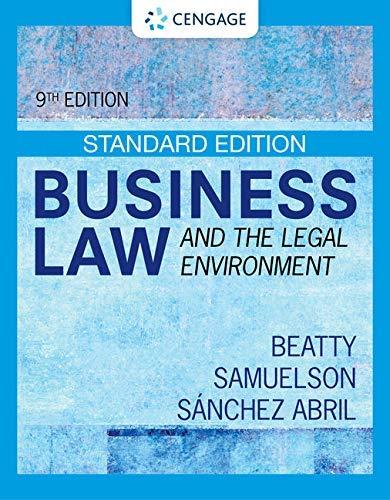Question
Mrs Fraser and Mr Booth lived in comfortable homes with lawns, gardens and water frontages and only a road separating their properties. Mr Booth had
Mrs Fraser and Mr Booth lived in comfortable homes with lawns, gardens and water frontages and only a road separating their properties. Mr Booth had lived in his home since 1943 and Mrs Fraser arrived in 1946. Soon after a problem arose between them.
Mr Booth was a pigeon fancier. His lofts, housing 350 birds, were the biggest in Sydney and his days were spent caring for them. For training purposes, he released the birds in lots of 50 to 100 at intervals throughout the day. They were allowed to fly around for a while and then he would call them back to the loft using noises such as shaking a tin full of pebbles. In between, he kept busy cleaning out the lofts.
Mrs Fraser hated the birds flying around her property. She found the swooping and swishing annoying and was disturbed by all the other noises such as the scraping to clean the lofts, the dog barking and the calling of the birds. Mrs Fraser decided to take legal action.
1. Who is the plaintiff and defendant?
2. Issue? will ____________ be successful in an action for private nuisance against __________
3. Law: Private Nuisance may be defined as? The defendant may have interfered with the plaintiff's comfort or the right to quiet enjoyment of the land in a number of ways: 4. Tree roots causing interference with the property of a neighbour?
5. Interference with support for land or buildings?
6. Watercourses, drains and gutters?
7. Causing dust and other emission
8. Escape of balls from sporting venues
Application:
9. Escape of balls from sporting venues
Application: The interference with comfort or quiet enjoyment of the plaintiff's land must be substantial and unreasonable. Factors which need to be considered include:
10. Nature of the interference
12. Duration or frequency of the interference
13. The nature of the locality
14. The motive of the defendant
15 Whether the "public interest" and the usefulness of the defendant's activity overrode any private rights for what would ordinarily be classed as a nuisance.
16 (1 point) According to the factors involved in determining whether the interference of the defendant was substantial and unreasonable, it has been shown that
17 (1 point) Actual Court Decision:
17 Defences available to the defendant include:
18 Did the plaintiff cause the nuisance?
19 Actual Court Case:
20. Is the plaintiff abnormally sensitive and the interference is trivial?
21. Actual Court Case:
22. All reasonable steps taken to minimise nuisance.
23. Actual Court Case:
24 Remedies available to the plaintiff include ______________, ______________, and ____________
Question 25 (1 point) The best possible remedy for the plaintiff would be Question 26 (1 point) Actual Court Remedies:
Step by Step Solution
There are 3 Steps involved in it
Step: 1

Get Instant Access to Expert-Tailored Solutions
See step-by-step solutions with expert insights and AI powered tools for academic success
Step: 2

Step: 3

Ace Your Homework with AI
Get the answers you need in no time with our AI-driven, step-by-step assistance
Get Started


